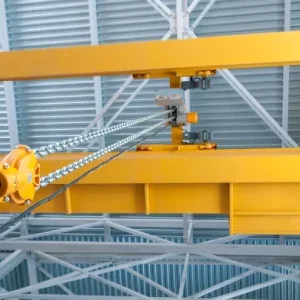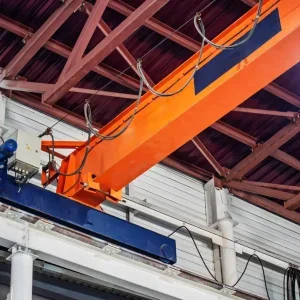The upper ends of the paddles are secured through pivots on horizontal axes to the outer frame so that the lower ends of the paddles pivot toward and away from each other. The pivoting range of the paddles goes between a closed position in which each paddle is vertical and an open position with the lower ends of the paddles pivoted away from the vertical central axis. Each paddle has a keyhole-shape opening near the lower ends. The patent application contains 20 separate claims.

Fig 1 – A perspective of an overhead crane with a bottom block assembly for transferring a nuclear fuel bundle between two buildings according to the invention.
Prior art
Conventional overhead cranes carry a bottom block that, together with an upper block and drum, raise and lower load hooks etc, attached to the bottom blocks. In nuclear reactor buildings such systems may transport fuel bundles between a reactor building and a containment building. In some facilities, the application states, the crane must pass through a door measuring 7ft high x 4ft wide (2.1×1.2m) into the containment room that is typically surrounded by concrete 4ft (1.2m) thick. Here the crane is typically installed on two underhung I-beams held about 16ft (4.88m) above the floor. The overhead crane engages the trunnions of a cask to lift and move it to a spent fuel pool and lowers it into the pool where it is filled with spent fuel roads, and then raised. The top of the cask has to be kept clear of obstructions to allow loading of the fuel rods, which means that the crane has to be disengaged whilst cask loading and re-engaged afterwards.
With the reactor facility dimensions (see above) there is little clearance between the trunnions of the cask and walls of the spent fuel pool. Typically current cranes use C-shape hooks to engage the trunnions, but these are thicker than the available space between the trunnions and the walls of the spent fuel pool and so do not function properly. This shows the need for an improved bottom block assembly.

Fig 2 – Perspective of the bottom block assembly with the pair of paddles in the closed position.
Description
The development addresses at least some of the problems in the related art as above. The essential construction of the development is as described in the abstract above.
In the figures the crane (10) includes a trolley (12), drum (14) carried by the trolley, and a bottom block assembly (16) to engage a nuclear fuel bundle cask (18). The cask has trunnions (20) to enable transportation. The crane also has an upper block (22) carried by the trolley and wire ropes (24) between the drum and bottom block assembly, and back up to the upper block. As usual the trolley moves on a pair of rails (26) sitting on girders (28) that may be on support beams (30). This positioning and relationship allows the crane to position the bottom block assembly and cask (18) practically anywhere along the linear path of the crane. Other configurations of the rails and support are valid.
The drum rotates about a horizontal axis and is connected to a motor (32) by means of speed reducers (34). The bottom block carries several sheaves (36) around which the wire ropes pass to lift or lower the bottom block assembly as the drum rotates.

Fig 3 – Side elevation of the bottom block assembly with the paddles in an open position.
The bottom block assembly includes a frame (38), a sheave block (40) carried by the main bottom block (38), and outer table of frame (42) rotatable relative to the main bottom block, and a pair of paddles (44) carried by the outer frame and pivotable relative to it to engage and disengage from the cask trunnions. The sheaves are ratably secured by a pin (46) on a common horizontally extending axis intersecting the vertical central axis (48) of the bottom block assembly.
The outer frame can rotate about the main bottom block and vertical axis on a slew bearing (50). This enables the trunnion paddles to be positioned near the cask trunnions. In Fig 4 the outer frame is rotated by a drive system (52) and an internal-toothed ring gear (54) and a pinion gear (56) ratably secured to the top of the bottom block and engaging the ring gear. There is a waterproof worm speed reducer driving the pinion gear and including a vertical input or drive shaft (60). Only the ring gear and pinion gear are exposed and should be made of a non-corroding material. The trolley carries a motor and spring-loaded engagement sleeve and so is never lowered into the spent fuel pond (see next paragraph). All electrical components of the drive system are also located on the trolley for the same reason.
Rotation of the outer frame only occurs when the bottom block assembly is in the full up position so that the drive shaft engages the sleeve and thus engages the motor. As the bottom block assembly is lowered the drive shaft is disengaged. The speed reducer will not rotate as it is self locking, so locking the outer frame relative to the main bottom block (Fig 4).
Pins (66) attach the paddles to the outer frame on opposite sides of the outer frame, to extend downwards. The paddles are pivotable about parallel and space-apart horizontal axes, which are perpendicular and spaced from the central vertical axis. Fig 3 shows the paddles in an outward pivoted position.
The lower end of each paddle has an opening or slot (Fig 2 – 70) for engaging the trunnion of the cask. The paddle completely encircles the slot. With the opening illustrated the slot has a larger circular portion (72) sized for passage of a large or flanged portion of the flask trunnions. A smaller lower part (74) is sized so that the same part of the trunnion will not pass through. The slot can have other shapes to suit the size and shape of the trunnions.
The illustrated paddles are thin enough for sufficient clearance between the cask and the sidewalls of the spent fuel pool so that the paddles can engage or disengage the cask. Once the trunnion paddles are moved to the closed position the bottom block assembly holds the cask.

Fig 4 – Top plan of the bottom block assembly showing the bottom block frame and the outer frame rotated through 45 degrees relative to the bottom block frame.
The paddles are pivoted between closed and open positions using an actuator system (76). As illustrated in Fig 3 this is a rope/pulley system or rope/lever system. It operates by tensioning a wire rope (78) passing through an inner bottom block positioned in the center of the larger sheave bottom block. The system includes springs (82) to bias the paddles to the closed position to engage a mechanical stop (84) formed by the outer frame. Tensioning the rope opens the paddles with a spring return on loosening the tension. The paddles shown are made of high-strength steel plates.
Activation of the paddles is by raising or lowering the inner bottom block. One end of the wire rope passes through an independent travelling sheave in the inner bottom block, and comes off the same drum as the main bottom block reeving. This maintains the same position as the main bottom block so that accidental actuation of the paddles can’t occur. The wire rope is dead-ended on the floating upper block (22) on the trolley where an actuator (86) is attached to tension and untension the rope.
In Fig 3 raising the inner bottom block puts tension on the paddle ropes that extend from the inner bottom block to actuation levers (90) secured to the outer frame. The ropes are connected to the inner bottom block with a bearing (92) so that the paddle ropes rotate with the outer frame. The paddle ropes also pass through a deflector or guide (94) on both sides of the main bottom block. The deflector shown sits on a bearing (96) so that the deflector rotates with the outer frame.
The bottom block assembly can include a lock mechanism (98) to secure the paddles in the closed position, and is released when the bottom block rope (78) is raised.
Operation
In operation, the trolley is moved until the bottom block assembly is positioned over the cask sitting on the floor. If needed the outer frame is rotated relative to the main bottom block to align the paddles with the cask trunnions. If needed the paddle operation rope is raised to tension it and actuate the paddles to pivot them to the trunnions. The bottom block assembly is lowered so that the paddles go over the trunnions, which engage and extend through the slots as the paddles go down over them. The tension on the rope is then released until the springs place the paddles in the closed position and engage the mechanical stops.
The bottom block assembly is then raised so that the smaller part of the paddle gaps slip over the trunnions to secure the cask to the bottom block assembly. The whole is then raised and the trolley carries the bottom block assembly and cask to the spent fuel pool.
If needed the outer frame is rotated to align the cask with a loading stand in the spent fuel pool. The bottom block assembly and cask are lowered into the pool. Once the bottom block assembly has been disengaged and raised from the cask (in a procedure opposite to that above), fuel bundles are loaded into the cask, the top of the cask plugged, and is then evacuated. The bottom block assembly is then lowered and secured to the cask as above, and lifted out of the pool with the cask. The trolley then moves them both over a transfer car and the cask is loaded onto the car. The patent application also includes a block diagram showing relationships of major components within the bottom block assembly and crane trolley of the invention. Although the invention is designed primarily to overcome a problem in handling nuclear fuel, the essential development can also be applied with alternative embodiments to related applications.
About the patent?
This article is an edited version of US Patent Application 20080085177 published on April 10 2008 and filed on August 16 2007. It incorporates the provisions of application number 60/838,281 filed on August 17 2007. The inventor’s previous patents have been assigned to MHE Technologies, Inc. of Wilmington, Delaware, a private company within the Konecranes Group. These include developments for a movable girder-mounted jib and a crane upper block. The agent for correspondence is Porter, Wright, Morris & Arthur Intellectual Property Group of Columbus, Ohio. The Morris headquarters and manufacturing plant of the Konecranes Group is also in Wisconsin (Oak Creek) making Morris and P&H brand products.
Disclaimer?
As an edited version of the original patent, this article and accompanying drawings may omit legally or technically important detail. To see the full application visit www.uspto.gov/patft/index.html






